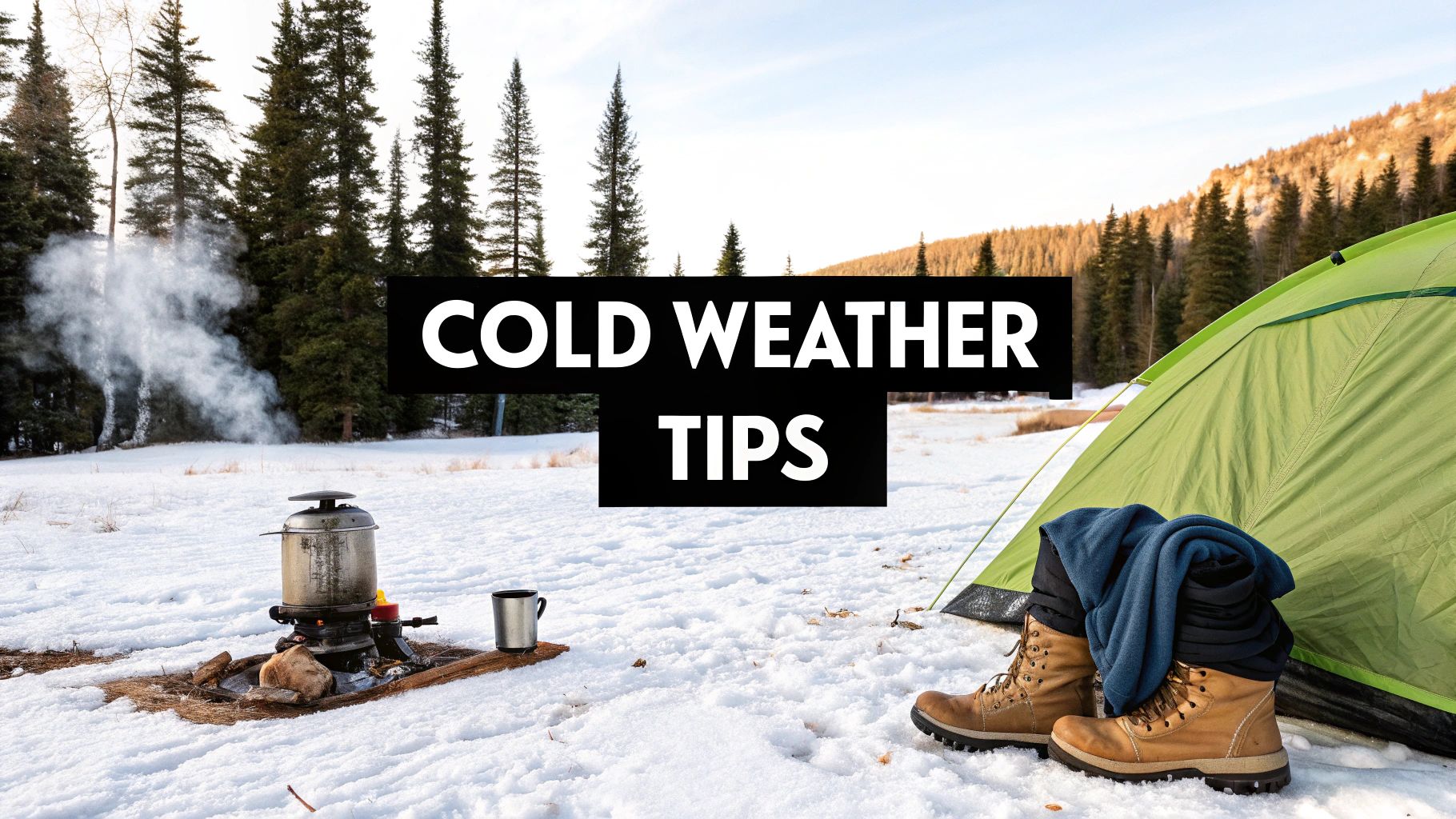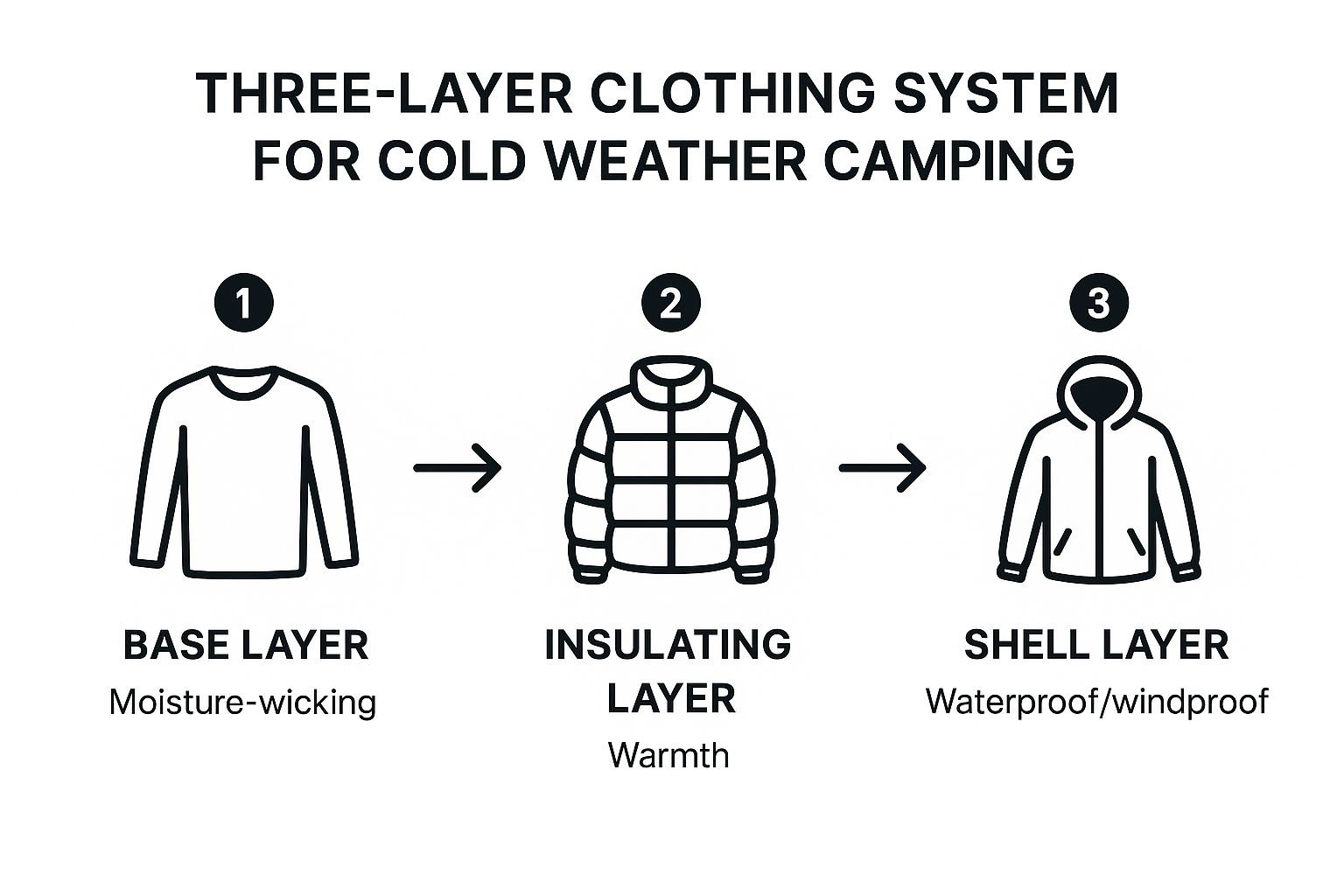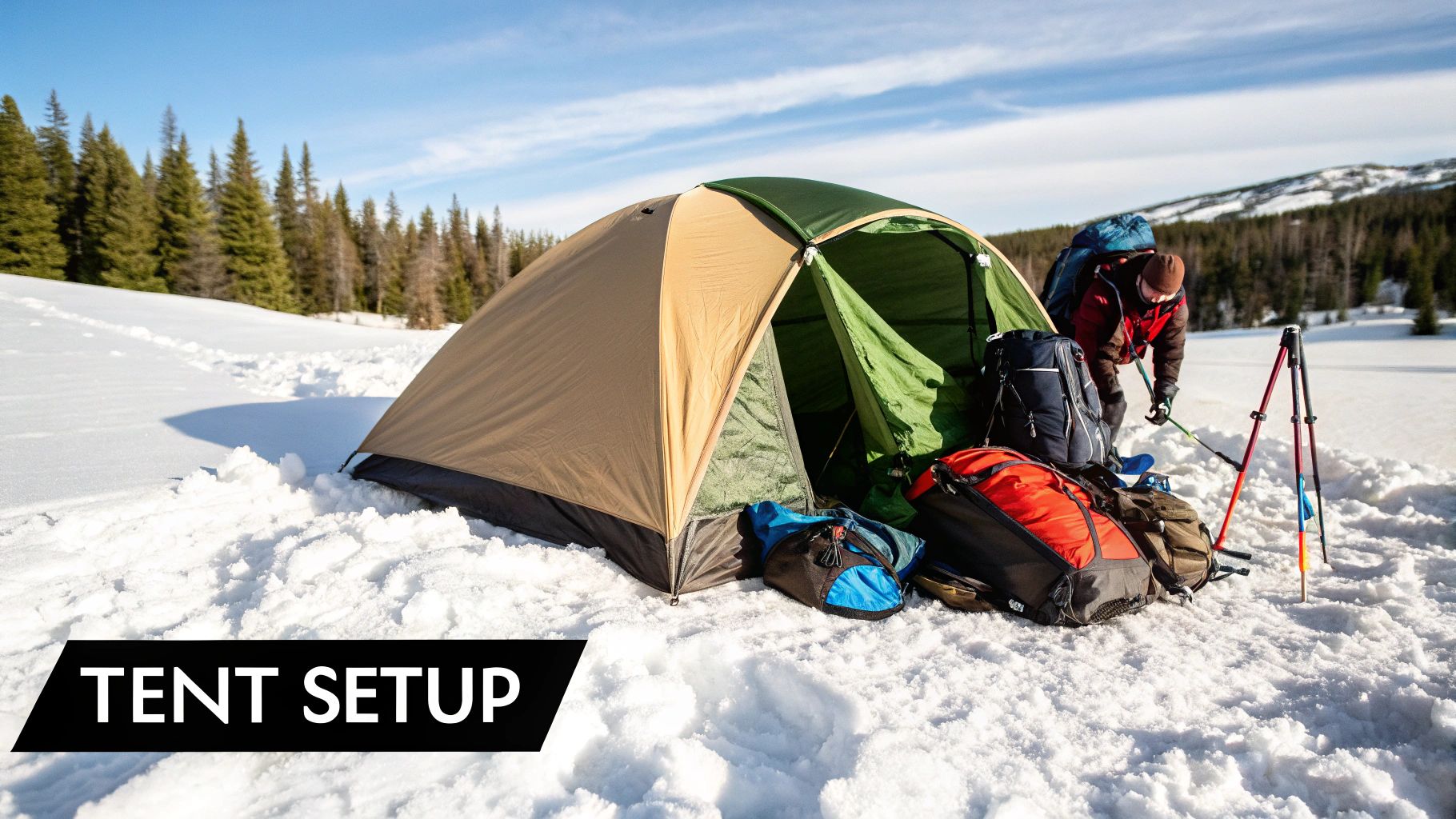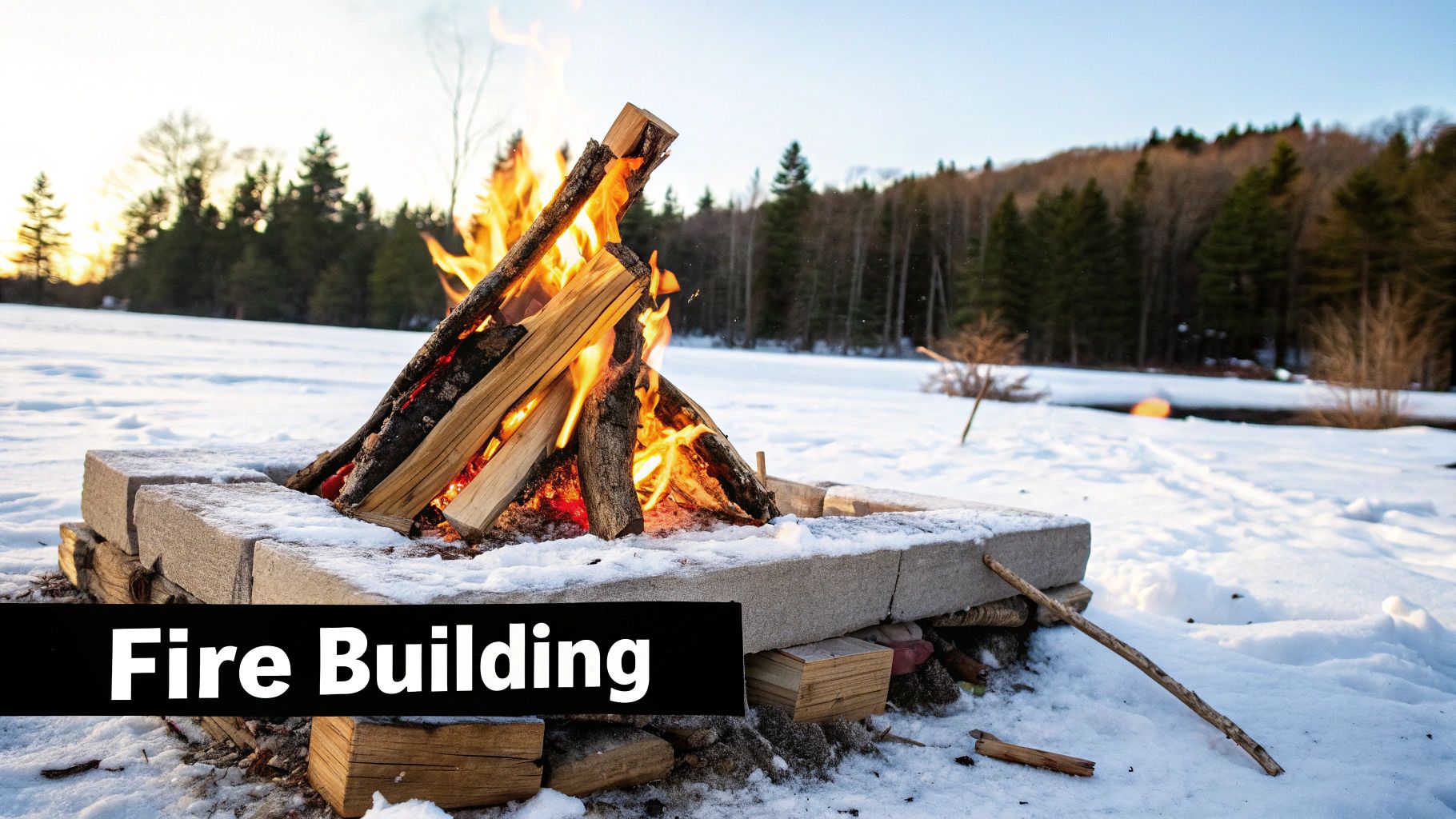
The crisp air, the pristine snow, and the profound silence of a winter landscape offer a unique magic that summer trips simply cannot match. But this profound beauty comes with a significant challenge: staying safe, comfortable, and warm when temperatures plummet. Successfully navigating these conditions isn’t about owning the most expensive gear; it’s about applying the right knowledge and techniques. This guide is designed to provide you with a comprehensive toolkit of actionable cold weather camping tips, moving beyond generic advice to deliver practical strategies you can implement immediately.
We will explore a systematic approach to winter excursions, covering the critical pillars of a successful trip. You will learn how to master a multi-functional layering system, optimize your tent for freezing temperatures, and build a sleep system that guarantees warmth through the night. Furthermore, we'll detail essential strategies for winter-specific nutrition and hydration, fire management, and critical moisture control for your gear. We also cover crucial safety protocols and winter-specific planning. Whether you're a seasoned adventurer looking to refine your skills or planning your first frosty night under the stars, these eight essential strategies will equip you to not just survive, but truly thrive in the cold.
1. Master the Art of Layering: Your Foundation for Warmth
The single most crucial skill for staying comfortable and safe in the cold is mastering the three-layer clothing system. This isn't just about piling on clothes; it's a strategic approach to thermal regulation that allows you to adapt to changing conditions and activity levels. By combining a base layer, an insulating mid-layer, and a protective shell, you create a microclimate around your body that you can fine-tune on the fly. This modular system is one of the most effective cold weather camping tips because it addresses the two biggest threats to your warmth: moisture from sweat and precipitation from the elements.
The Three Core Layers
Each component in the system serves a distinct, vital function. Understanding their roles is key to making it work for you.
- Base Layer (Wicking): This is your second skin. Its primary job is to pull moisture (sweat) away from your body to keep you dry. Materials like merino wool or synthetic polyesters (e.g., Capilene) excel here. Crucially, never wear cotton as a base layer, as it absorbs moisture and rapidly pulls heat from your body once you stop moving.
- Insulating Layer (Warmth): Worn over the base layer, this is your warmth engine. Its purpose is to trap the air your body heats up. Common materials include fleece, down, or synthetic insulation. The thickness of this layer can be varied depending on the temperature. You might opt for a lightweight fleece on a cool day or a thick down puffy jacket for deep winter conditions.
- Shell Layer (Protection): This is your armor against wind, rain, and snow. A good shell is both waterproof and breathable, allowing moisture vapor from your inner layers to escape while blocking external precipitation. Jackets using Gore-Tex or similar proprietary membranes are the gold standard for this. For a deeper dive into shell options, you can learn more about choosing the best lightweight winter jacket.
This infographic illustrates the proper sequence for building your adaptable clothing system.

As the diagram shows, each layer builds upon the last to create a complete, high-performance system for thermal regulation.
Putting It Into Practice
The real magic of layering is its adaptability. Start your hike "cold" with minimal layers; you'll warm up quickly. Before you start sweating heavily, open vents or remove your insulating layer. When you stop for a break, immediately add your insulating layer back on to trap body heat before you get chilled. This constant adjustment is the key to all-day comfort and safety.
2. Four-Season Tent Setup and Cold Weather Modifications
Your shelter is your lifeline in freezing conditions, and its effectiveness goes far beyond the tent model you choose. Proper setup and strategic modifications are essential for maximizing warmth, managing condensation, and withstanding harsh winter elements like wind and snow. This approach transforms your tent from a simple shelter into a robust, warm basecamp, which is why it's one of the most critical cold weather camping tips. It addresses the primary challenges of winter camping: heat loss, moisture buildup, and structural integrity under load.

Key Shelter Considerations
Successfully setting up a winter shelter involves specific techniques that are less critical in warmer seasons. These practices help your tent perform at its peak.
- Site Selection and Preparation: Choose a site protected from the wind, like in a stand of trees. Before pitching, firmly pack down the snow where your tent will go. This creates a solid, flat platform and prevents the snow from melting unevenly under your body heat, ensuring a more comfortable and level sleeping surface.
- Anchoring and Stability: Standard tent stakes are often useless in deep snow or frozen ground. Instead, use specialized snow stakes or "deadman" anchors by burying stuff sacks filled with snow. Always use every guyline on your tent to create a taut structure that can shed snow and resist high winds effectively. Ski poles or ice axes can also serve as robust emergency anchors.
- Ventilation and Condensation: A sealed tent will trap moisture from your breath, which will then freeze on the inner walls. It's crucial to use your tent's vents, even when it's frigid outside. Cracking a door or window slightly creates cross-ventilation that whisks moisture out before it can accumulate and compromise the insulating properties of your sleeping bag.
Putting It Into Practice
Small adjustments to your tent setup can make a significant difference. Before entering your tent, brush all loose snow off your clothing and gear to keep the interior dry. Regularly clear accumulated snow from the tent's roof and sides to prevent heavy loading that could damage the poles. For added warmth and organization, consider digging a small "cold sink" trench in the vestibule area; this deeper spot traps the coldest air, making the main living space feel warmer. By implementing these techniques, you ensure your shelter remains a safe and reliable haven.
3. Cold Weather Sleep System: Bag, Pad, and Temperature Management
A warm night's sleep is not just about comfort; it's a critical safety component of cold weather camping. Your sleep system is more than just a sleeping bag; it's an integrated setup designed to combat heat loss from all directions. This system-based approach is one of the most vital cold weather camping tips because it addresses the often-underestimated threat of conductive heat loss to the frozen ground, which can rob you of warmth far faster than the cold air.
The Three Core Components
Your sleep system must function cohesively to keep you warm through the night. Each part plays a specific and essential role in preventing heat loss.
- Sleeping Bag (Insulation): This is your primary defense against cold air. Look for a bag with a temperature rating that is at least 10-15°F lower than the coldest temperature you expect to encounter. Down and synthetic fills both work, but down offers a better warmth-to-weight ratio, while synthetics perform better when damp.
- Sleeping Pad (Ground Insulation): This is arguably the most critical component. When you lie in a sleeping bag, your body weight compresses the insulation beneath you, rendering it nearly useless. A sleeping pad with a high R-value (a measure of thermal resistance; aim for 5 or higher for winter) insulates you from the cold ground. A combination of a closed-cell foam pad and an insulated inflatable pad offers maximum protection and redundancy.
- Temperature Management (Active Warmth): This involves the techniques you use to maximize the efficiency of your gear. It includes actions taken before you even get into your bag, such as changing into dry sleep clothes and doing light exercises like jumping jacks to generate body heat. For a comprehensive guide on selecting the right primary component, you can learn more about choosing a sleeping bag that actually keeps you warm.
Putting It Into Practice
Building an effective sleep system means preparing before you feel cold. Never go to bed cold, as your sleeping bag only traps the heat you produce; it doesn't generate its own. Before turning in, eat a high-calorie snack and drink a warm, non-caffeinated beverage to fuel your internal furnace. If you use a Nalgene-style hard bottle, fill it with hot water and place it in your sleeping bag near your core or feet to act as a personal heater throughout the night. Always ensure your pad is fully inflated and positioned correctly to prevent any contact with the cold tent floor.
4. Hydration and Nutrition Strategy for Cold Weather
Your body is a furnace, and in the cold, it needs a constant supply of high-quality fuel and water to keep burning hot. Proper nutrition and hydration are not just about comfort; they are critical cold weather camping tips for maintaining energy and core body temperature. Cold, dry air accelerates dehydration, while your metabolism works overtime just to stay warm, burning anywhere from 300 to 500 extra calories per day. A strategic approach to what you eat and drink is fundamental to your safety and enjoyment.
The Two Pillars of Your Internal Furnace
Fueling your body correctly in the cold involves a dual focus on high-energy foods and consistent hydration, both of which present unique challenges in freezing temperatures.
- Caloric Density (Fuel): Your body needs more calories to generate heat through thermogenesis. Focus on foods that are high in fats and complex carbohydrates, as they provide sustained energy. Fats are particularly calorie-dense, offering more energy per gram than carbs or proteins. Think of adding coconut oil or olive oil to freeze-dried meals, or snacking on nuts, seeds, and jerky.
- Hydration (Engine Coolant & Function): It's easy to forget to drink when you don't feel thirsty, but you lose significant moisture just by breathing in cold, dry air. Dehydration thickens your blood, making your heart work harder and increasing your risk of hypothermia. Aim to drink water consistently throughout the day, even when you don't feel a strong sense of thirst.
Putting It Into Practice
Adapting your eating and drinking habits to the cold is key. Small, consistent actions prevent your energy and hydration levels from crashing.
- Eat small and often to provide a steady stream of fuel for your metabolic furnace, rather than relying on two or three large meals.
- Keep snacks accessible in a pocket to eat on the move. This prevents long, cold stops and keeps your energy levels stable.
- Prevent water from freezing by using insulated bottle carriers like a neoprene sleeve on a Nalgene. On overnight trips, sleep with your water bottle inside your sleeping bag.
- Start and end the day hydrated. Drink a full bottle of water upon waking and before bed. Add electrolyte mixes to your hot drinks to help with fluid absorption.
5. Fire Building and Heat Source Management
Managing your heat sources effectively is a critical skill that goes beyond simply starting a fire. It involves understanding how to build a sustainable heat source in challenging, often damp or snowy, conditions and how to safely utilize both campfires and portable heaters. Proper heat management is one of the most vital cold weather camping tips because it provides not only warmth and a psychological boost but also a means to dry gear, cook food, and melt snow for water. The goal is to create consistent, directed heat without compromising safety or depleting your energy.

Core Heat Source Techniques
From ancient survival methods to modern technology, your approach to heat will depend on your environment, gear, and camping style. Each has specific applications and safety considerations.
- Building a Fire on Snow: A common challenge is preventing your fire from melting its way down into the snow and extinguishing itself. The solution, popularized by survival experts like Mors Kochanski, is to build a log platform. Lay several green, non-combustible logs side-by-side directly on the packed snow to create a solid base that insulates the fire from the ground.
- Heat Reflectors: A fire radiates heat in all directions, but you only benefit from the heat aimed at you. Create a reflector wall behind your fire using a space blanket, a tarp, or by piling up snow or logs. This wall will bounce radiant heat back towards your shelter and sitting area, dramatically increasing warmth and efficiency.
- Portable Heaters: For car camping or base camps, propane heaters like the Mr. Heater Buddy can provide reliable, controlled warmth. For hot-tenting, a wood-burning tent stove offers significant heat and a cooking surface. Crucially, never use any unvented fuel-burning appliance inside a sealed tent or sleeping area due to the severe risk of carbon monoxide poisoning.
Putting It Into Practice
Success lies in preparation and safe execution. Before you even strike a match, gather all the tinder, kindling, and fuel you will need; finding wood in the dark and cold is difficult and dangerous. When building your fire, ensure it has adequate airflow from below but is protected from strong winds. For portable heaters, always follow manufacturer instructions for ventilation and clearance from flammable materials. By thinking strategically about heat creation and direction, you can turn a cold campsite into a comfortable haven.
6. Protect Your Gear from the Cold's Corrosive Touch
One of the most overlooked cold weather camping tips is actively managing your equipment. Cold temperatures don't just affect you; they drain batteries, make plastics brittle, and turn moisture into destructive ice. Protecting your gear is as critical as protecting yourself, as a failed headlamp, a dead phone, or a frozen water filter can quickly escalate from an inconvenience into a serious safety issue. Effective gear management involves anticipating the cold's impact and taking preemptive steps to mitigate it.
Key Gear Vulnerabilities and Solutions
Your equipment has two main enemies in the cold: plunging temperatures and invasive moisture. Here is how to defend against both.
- Electronics and Batteries: Cold drastically reduces the chemical efficiency of batteries. A phone or GPS unit left in an outside pack pocket can die in a fraction of its normal time. Always store electronics and spare batteries inside a warm pocket close to your body, or tucked deep inside your sleeping bag at night.
- Insulation and Moisture: Moisture is the enemy of warmth. A down sleeping bag or jacket that gets wet from condensation or melting snow will lose nearly all its insulating properties. Keep these critical items in waterproof dry sacks (like a Sea to Summit eVent compression sack) even when they are inside your main pack.
- Water and Filtration: Water expands when it freezes, which can crack Nalgene bottles and permanently destroy the hollow-fiber elements inside common water filters. Always sleep with your water bottle and filter inside your sleeping bag to prevent them from freezing solid overnight.
Putting It Into Practice
Develop a routine for managing your gear at camp. Before bringing anything into the warmth of your tent, vigorously shake or brush off all accumulated snow to prevent it from melting and soaking your interior. Before bed, create a designated spot in your sleeping bag for your electronics, water bottle, and filter. Lastly, always keep one complete set of dry clothes (base layer, socks, etc.) sealed in a waterproof bag. This is your emergency "reset" button if you get soaked, and it must be protected at all costs.
7. Emergency Preparedness and Cold Weather Safety Protocols
While proper gear and techniques prevent most issues, cold weather camping demands a robust emergency plan. The stakes are significantly higher when temperatures drop, as a simple mistake can quickly escalate into a life-threatening situation. Having established safety protocols and practicing emergency skills isn't just a backup plan; it's a core component of responsible winter travel, ensuring you can manage unforeseen challenges from equipment failure to sudden weather shifts. This proactive mindset is one of the most critical cold weather camping tips for ensuring a safe return.
Core Safety and Emergency Skills
Your preparedness plan should cover key areas of self-rescue and group safety. Knowing how to react calmly and correctly is more valuable than any piece of gear.
- Recognize Cold Injuries: Learn the early signs of hypothermia (shivering, slurred speech, clumsiness) and frostbite (numb, waxy skin). Early detection and treatment are crucial. For hypothermia, this involves removing wet clothes, insulating the person, and providing warm, sugary liquids.
- Emergency Shelter: If you are stranded, a shelter is your top priority. Practice building a snow cave or a trench shelter, which uses the insulating properties of snow to protect you from wind and extreme cold. Even carrying a lightweight emergency bivy can be a lifesaver.
- Signaling for Help: Know how to use your emergency communication devices. A Personal Locator Beacon (PLB) or satellite messenger is invaluable for off-grid emergencies. Also, carry a loud whistle and a signal mirror as reliable, low-tech backups.
Putting It Into Practice
Integrate these protocols into every trip plan. Before you leave, establish a firm turnaround time and leave your detailed itinerary with a reliable contact. During the trip, constantly assess your group's condition and the weather. If someone shows early signs of hypothermia, stop immediately and address it. If conditions deteriorate, be willing to retreat rather than push forward into a dangerous situation. Having a charged power bank for your GPS and phone is vital for navigation and communication. Alternatively, for a quieter and more sustainable emergency power source, consider reliable off-grid solar power solutions to keep essential electronics charged.
8. Weather Assessment and Route Planning for Winter Conditions
In standard camping, weather dictates comfort; in winter camping, it dictates survival. A successful cold-weather trip hinges on diligent pre-trip planning and a deep respect for the volatility of winter conditions. This involves more than a quick glance at a weather app. It requires a comprehensive approach to interpreting forecasts, understanding terrain-specific hazards, and creating flexible plans that prioritize safety over mileage. This is one of the most vital cold weather camping tips because it proactively addresses risks before you even leave home.
The Two Pillars of Winter Planning
Effective planning for cold conditions breaks down into two interconnected components: understanding the weather and adapting your route accordingly.
- Advanced Weather Assessment: Winter weather is complex and can change with shocking speed. Rely on multiple, credible sources to build a complete picture. Use the National Weather Service's (NWS) point forecasts for detailed, location-specific data. For mountain travel, consult specialized resources like the National Avalanche Center (Avalanche.org) for bulletins on snowpack stability. Learning to read a synoptic weather chart or monitor barometric pressure trends on a watch can provide real-time insights into approaching systems.
- Contingency-Based Route Planning: Winter travel is slower and more strenuous. Snow, ice, and reduced visibility can turn an easy summer trail into a challenging endeavor. Plan your route with conservative daily mileage goals that account for shorter daylight hours. Crucially, for every day of your trip, identify potential "bail-out" routes or emergency exit points. Your plan must be fluid, with built-in buffer days to wait out storms or hazardous conditions.
Putting It Into Practice
Before your trip, study historical weather patterns for the area and season. Are you in a region known for lake-effect snow or strong afternoon winds? During the trip, make weather observation a constant activity. Notice changes in cloud formations, wind direction, and temperature. This situational awareness allows you to make informed decisions, such as setting up camp early before a storm hits or turning back if conditions deteriorate beyond what you planned for. Combining these observations with solid navigation is key, which is why it's important to learn how to use a map and compass for reliable orientation when technology fails.
Cold Weather Camping Tips Comparison Matrix
| Item | Implementation Complexity 🔄 | Resource Requirements ⚡ | Expected Outcomes 📊 | Ideal Use Cases 💡 | Key Advantages ⭐ |
|---|---|---|---|---|---|
| The Layering System: Base, Insulating, Shell | Moderate – requires knowledge to use effectively | Moderate – multiple quality clothing layers | Maintains core temperature; adapts to conditions | Cold weather camping with variable temps | Highly adaptable; lightweight; moisture control |
| Four-Season Tent Setup & Cold Weather Modifications | High – time consuming and skill-intensive | High – specialized tent and anchoring tools | Warm microclimate; snow and wind protection | Winter camping in heavy snow and wind | Raises temp inside tent; protects gear and occupants |
| Cold Weather Sleep System: Bag, Pad, Temperature Management | Moderate to high – selecting correct rating and managing moisture | High – specialized sleeping bag and pad | Prevents hypothermia; quality sleep | Snow camping and extreme cold overnight stays | Ground heat loss prevention; modular layering |
| Hydration and Nutrition Strategy for Cold Weather | Moderate – planned logistics and meal prep | Moderate to high – extra/high-calorie foods and insulated containers | Sustained energy; prevents dehydration | Multi-day cold weather expeditions | Maintains energy and immune support; hydration management |
| Fire Building and Heat Source Management | High – requires skill, fuel prep, and safety measures | Moderate – fuel and fire-starting materials | Essential warmth and morale boost | Campsites allowing open fires or stove use | Life-saving heat; drying gear; cooking capability |
| Gear Protection and Moisture Management | Moderate – continual attention and storage care | Moderate – vapor barriers and waterproof gear | Prevents gear failure; maintains insulation | Prolonged cold trips with risk of condensation | Protects gear; reduces moisture damage |
| Emergency Preparedness and Cold Weather Safety Protocols | High – extensive training and practice | Moderate to high – emergency gear and knowledge | Prevents fatalities; ensures safe response | All cold weather camping, especially remote locations | Saves lives; builds confidence; enhances response |
| Weather Assessment and Route Planning for Winter Conditions | High – requires experience and data interpretation | Low to moderate – access to weather tools and info | Avoids hazardous conditions; optimizes schedule | Backcountry winter travel and expedition planning | Reduces risk; enables safe travel decisions |
Your Next Winter Adventure Awaits
Venturing into the wild during winter can seem daunting, but as we've explored, the right knowledge transforms a potentially intimidating challenge into an exhilarating and deeply rewarding experience. The crisp air, the profound silence of a snow-covered landscape, and the solitude are rewards reserved for the well-prepared. This comprehensive guide to cold weather camping tips has provided the foundational pillars for not just surviving, but truly thriving in frigid conditions.
From Knowledge to Mastery
The journey from novice to confident winter camper is built upon the consistent application of key principles. It's not about having the most expensive gear; it's about understanding the why behind each action.
- Systematic Preparation: Success begins long before you reach the trailhead. It lies in your meticulous approach to layering, creating a robust sleep system, and planning calorie-dense meals. Each element works in concert with the others.
- Proactive Management: Cold weather camping is a game of proactive management, not reactive crisis control. This means managing moisture before you get damp, staying hydrated before you feel thirsty, and constantly assessing weather conditions and your own physical state.
- Respect for the Environment: The most crucial takeaway is a deep respect for the power of winter. This respect informs every decision, from choosing a sheltered campsite and assessing avalanche risk to building a safe fire and leaving no trace.
Mastering these concepts is about more than just staying warm; it's about unlocking a new season of adventure. It builds resilience, sharpens your outdoor skills, and provides a powerful sense of self-reliance. When you can comfortably make a warm shelter and a hot meal as the temperature drops, you connect with the outdoors on a much deeper level.
Your Actionable Next Steps
Don't let this knowledge remain theoretical. The best way to solidify these cold weather camping tips is to put them into practice. Start with a low-risk overnight trip in your backyard or a familiar local campsite with a clear forecast. Test your layering system on a cold day hike. Practice setting up your tent while wearing gloves. Each small, controlled test builds the muscle memory and confidence you'll need for more ambitious trips. Review your emergency plan, check your gear, and then commit to a date. The serene beauty of the winter wilderness is waiting for you.
Ready to ensure your gear is as reliable as your newfound skills? Explore the curated collections of outdoor essentials on FindTopTrends, where we help you compare and choose the best equipment for your cold weather adventures. From high-performance base layers to dependable four-season tents, find everything you need at FindTopTrends.










